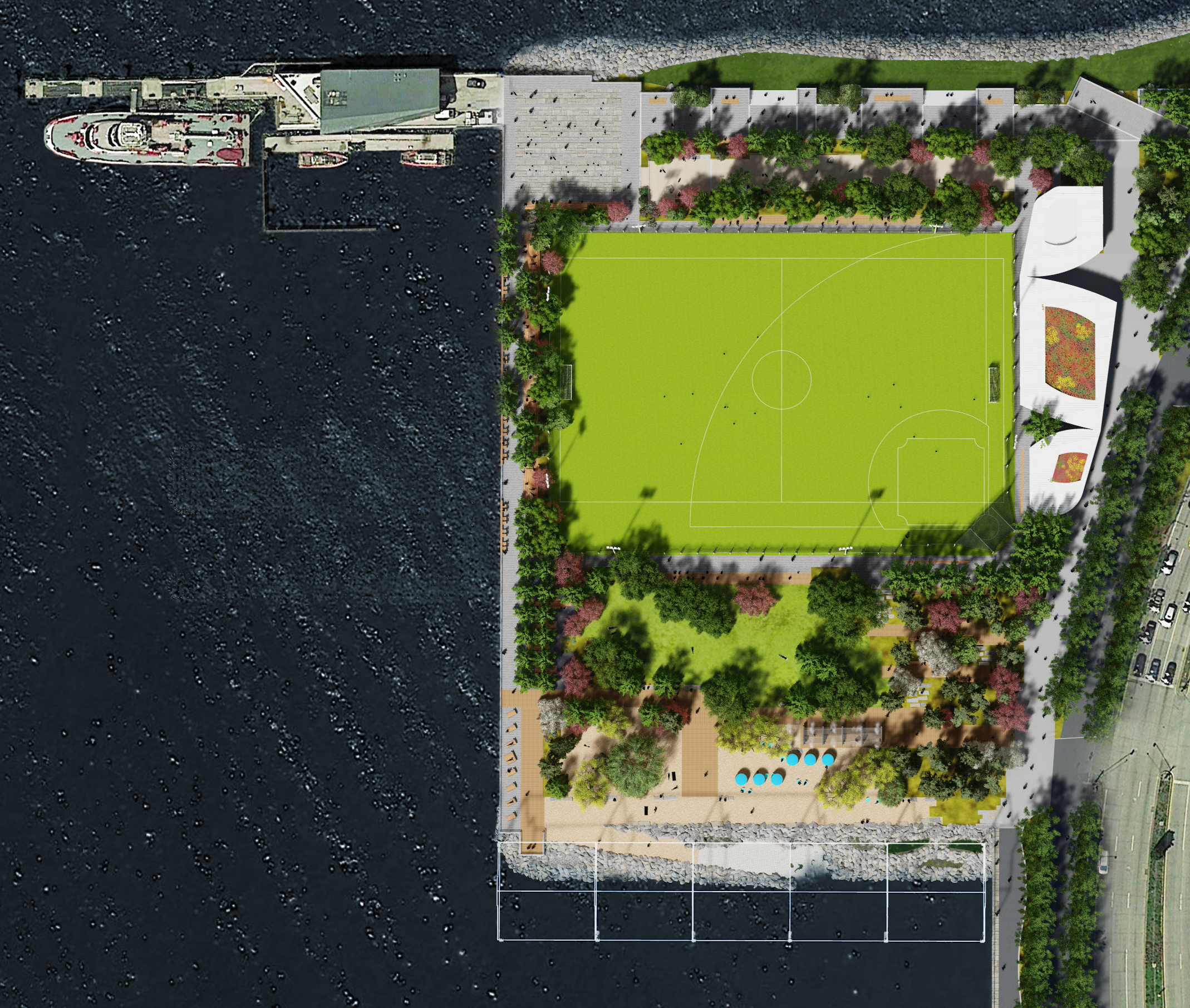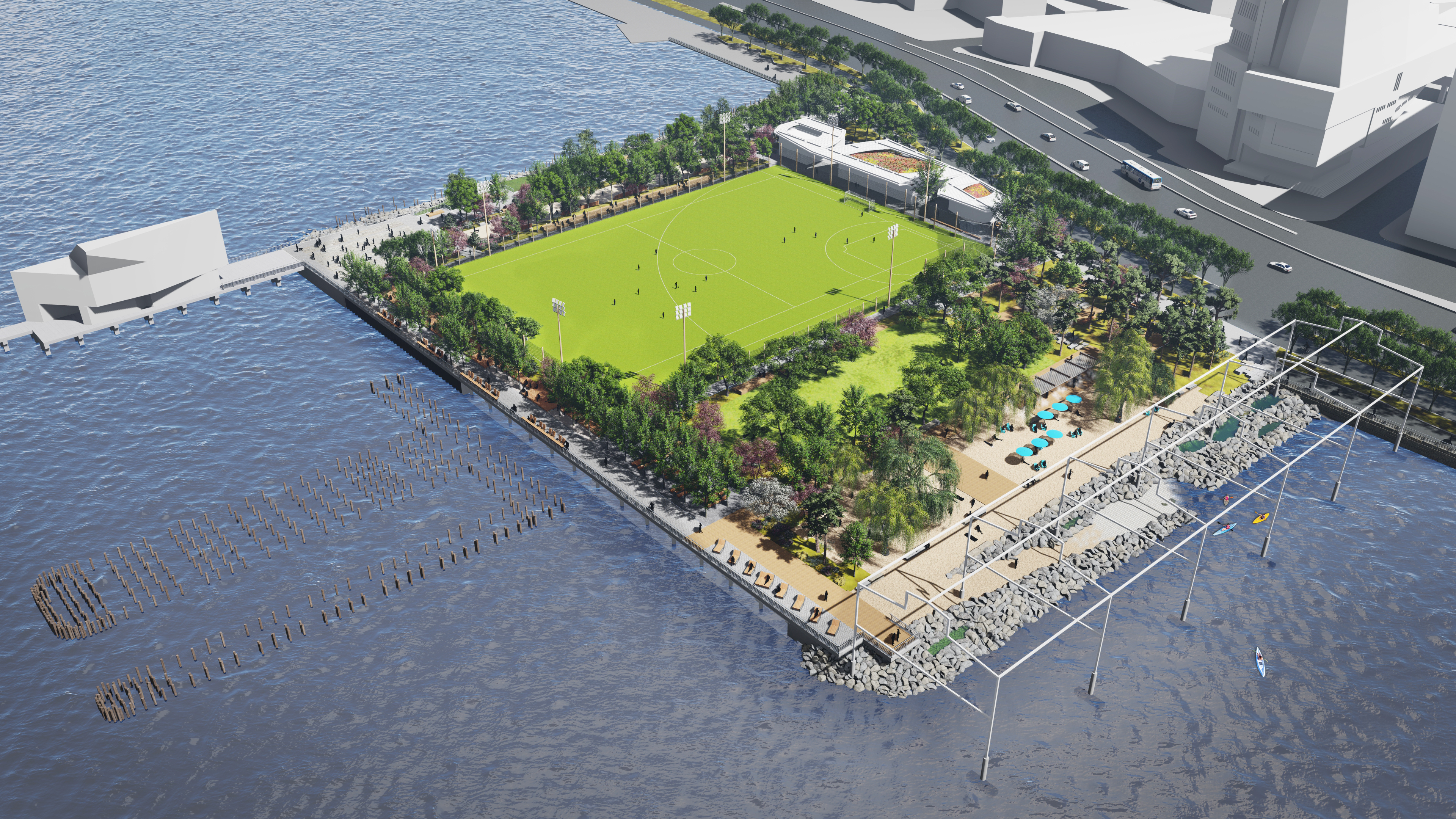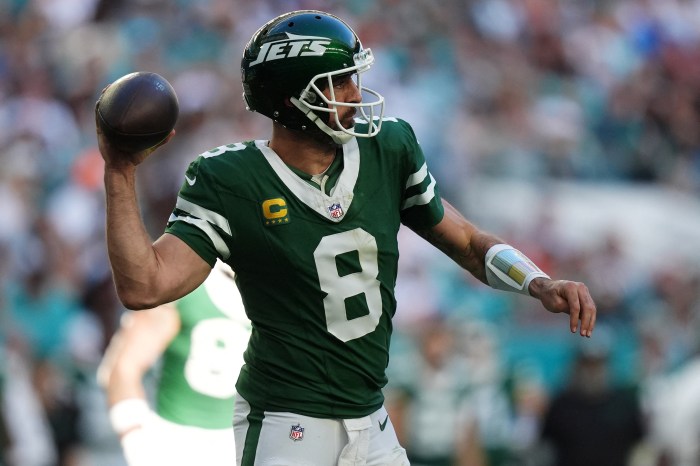
BY LINCOLN ANDERSON | The Hudson River Park Trust and its hired landscape architects presented an updated design for the planned park on Gansevoort Peninsula last week, and it contains a regulation, high-school-size soccer field. But there are still some community concerns about the treatment of the planned “beach” on the peninsula’s southern edge.
Gansevoort — just across the highway from the Meatpacking District in the Village’s northwest corner — is the last remnant of landfill along the Lower West Side’s shoreline that once extended out to a 13th Ave., before the rest of it was cut back to accommodate increasingly large ships.
The new design, by James Corner Field Operations, includes the larger field — which was a request by local youth leagues at previous meetings and presentations — as well as a dog run. But there is no storage for kayaks and other small boats. Also, the long-promised sandy beach is actually elevated, with the area by the water filled with a riprap of large boulders, which waterfront park and boating activists say makes it inaccessible to the river. And having access to the water is something that Community Board 2 favors.
“This design is not friendly to getting into the water,” said Dan Miller, the board’s first vice chairperson and also co-chairperson of the Hudson River Park Advisory Council.
“These are sharp-edged stones,” he said of the riprap area. “They are effective for keeping erosion from happening. But the idea is to give people a chance to access the water — not to swim, but to put your feet in. The riprap is dangerous. It’s like anytime you walk on jetty,” he said of the potentially treacherous footing. “A major failure of the design is the south side of the peninsula. I’m guessing the trust doesn’t want the liability of people swimming. But on a nice sunny day, wouldn’t it be nice to put your feet in the water?”
The southern side’s design does clearly sport a ramp down to the water for putting boats into the river and taking them out. But the rest of that side of the peninsula lacks water access beyond that “get down” spot.
Miller even speculated that the Whitney and David Hammons back the riprap, as opposed to a sandy beach sloping down to the water, because Hammons wants to recreate exactly the look of the former Pier 52 for his “Day’s End” sculpture. Or maybe the Spectra high-pressure gas pipeline — which lies under this part of the peninsula — is somehow a factor, as well, he added, again making a gradual slope down to the water a problem.
C.B. 2 is also recommending that some sort of bubble be added over the sports field in the winter to allow year-round sports. The field will be covered with artificial turf, not grass, which Miller said will be designed to drain better than real grass. The field at Pier 40, at W. Houston St., which sits atop a concrete deck, has poor drainage, he noted.

The local youth soccer leagues, Downtown United Soccer Club and Downtown Soccer League, are calling not for an “air bubble,” per se, but a clear plastic dome to cover the field. Also, for baseball, Miller said, the Greenwich Village Little League wants the backstop switched to Gansevoort’s western side, since home runs hit onto the West Side Highway would be rarer than balls fouled back from the backstop, which could be a problem if the backstop is kept on the peninsula’s eastern side. The leagues are also recommending retractable netting be installed, which could be retracted when games are not underway, so as not to spoil the park’s aesthetics.
Miller said the field’s shape is “a little funky” for baseball, but workable. The large field can also be subdivided into four for smaller games or younger athletes.
C.B. 2 members on the Parks and Waterfront Committee were reportedly generally favorable to the latest plan shown last week, and the full board is slated to vote on it at its meeting on Thurs., Sept. 19.
However, a Trust spokesperson said the plan has been well received by the community.
“We’ve worked hard to provide the largest field possible while also fulfilling other community hopes for Gansevoort, such as a lawn and pine grove for passive recreation, a beach, habitat restoration and dog run,” he said. “We’re pleased that the plans were so well received at both the July and September Community Board 2 meetings we attended and we’re looking forward to starting construction [on the Gansevoort park] next year.”
As for the suspicions that the design of Gansevoort’s southern side is intended to keep people out of the water or honor Hammons’s artistic vision or protect the Spectra pipeline, whose installation six years ago was so hotly opposed by the community, the spokesperson, well…threw water on all of them.
“None of [that] is even remotely a correct interpretation of any aspect of our design or design intent,” he scoffed. “And the reason we and our design team have attended or even organized multiple community meetings specifically about Gansevoort over this past year is so that people can talk to us about their ideas and concerns directly.”



































